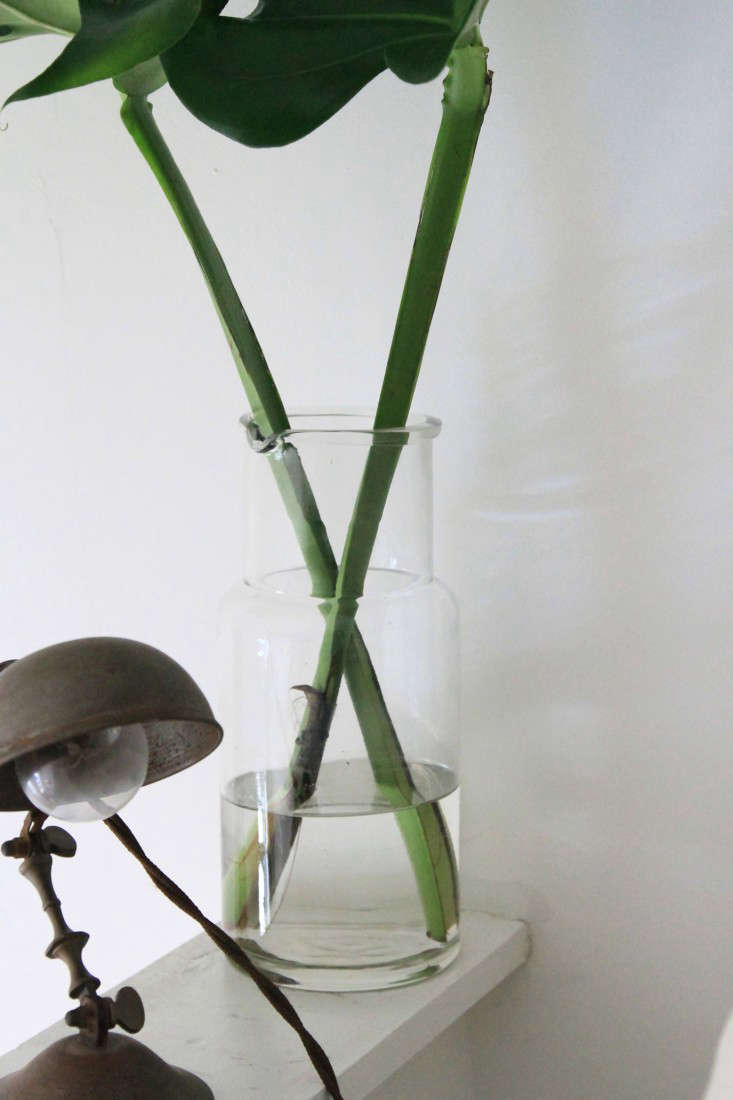Big tree, tiny apartment: can this relationship be saved?
Monstera deliciosa plants are so beautiful. But I think of large plants as existing in the same category as large dogs. There’s no space for either in my tiny apartment.
The solution? I stopped by my neighborhood florist to buy a leaf or two instead of an enormous plant. Turns out that’s all you need to introduce a bit of the tropics into your home:
Photography by Erin Boyle.
Above: Monstera Deliciosa—also known as Swiss Cheese Plant or Monster Plant, and commonly confused with Split Leaf Philodendron (which is of a different genus)—is native to the balmy tropical rain forests of southern Mexico and Central America. There it climbs into the tree canopy, attaching tentacle-like roots to trunks and branches. The plant’s leaves and stems are poisonous, but the strangely shaped fruit is perfectly edible (and sounds delicious, with a flavor that’s a combination of banana, pineapple, and mango).
Above: If you haven’t explored the tropics lately, it’s likely you’ve seen Monstera deliciosa more often in offices and homes with impressive plant collections. The plant has been creeping into interior design styling with increased regularity and while I don’t think it’ll edge out the Fiddle Leaf Fig in the race for most coveted houseplant, it’s a contender. Its large glossy leaves are deeply lobed with elongated holes, and they make impressive additions to rooms that need greenery.
Despite its rain forest roots, the plant is fairly tolerant of dry air and indirect light and does well in indoor containers. But its leaves can grow up to 3 feet long, so you’ll need to make sure that you’ve got plenty of floor space to spare. If you have the room for it and want to start with a baby plant, a Monstera Deliciosa Plant in a 6-inch pot is $25 from Pernell Gerver.
Above: I do not have the room for a full-grown plant. So I recently purchased two Monstera Deliciosa leaves from the corner florist shop for $4 each. I filled a large vase with a small amount of water, made a fresh cut on the end of the leaves, and plopped them into the vase. With a water change every few days, my leaves lasted for more than three weeks.
Above: Leaves purchased from the flower shop likely won’t root, but if you’re lucky enough to know someone with a plant and you’d like to root a cutting yourself, the process is fairly simple. Make sure to start with a stem that has some of its aerial roots still attached. These will continue to grow in water and can be repotted if you decide you’d like a more permanent addition to the family.
In the market for something more permanent? See all of our Houseplant Posts.
Finally, get more ideas on how to successfully plant, grow, and care for monstera with our Monstera: A Field Guide.
Finally, get more ideas on how to plant, grow, and care for various houseplants with our Houseplants: A Field Guide.
Interested in other tropical plants for your garden or indoor space? Get more ideas on how to plant, grow, and care for various tropical plants with our Tropical Plants: A Field Guide.

















Have a Question or Comment About This Post?
Join the conversation (4)